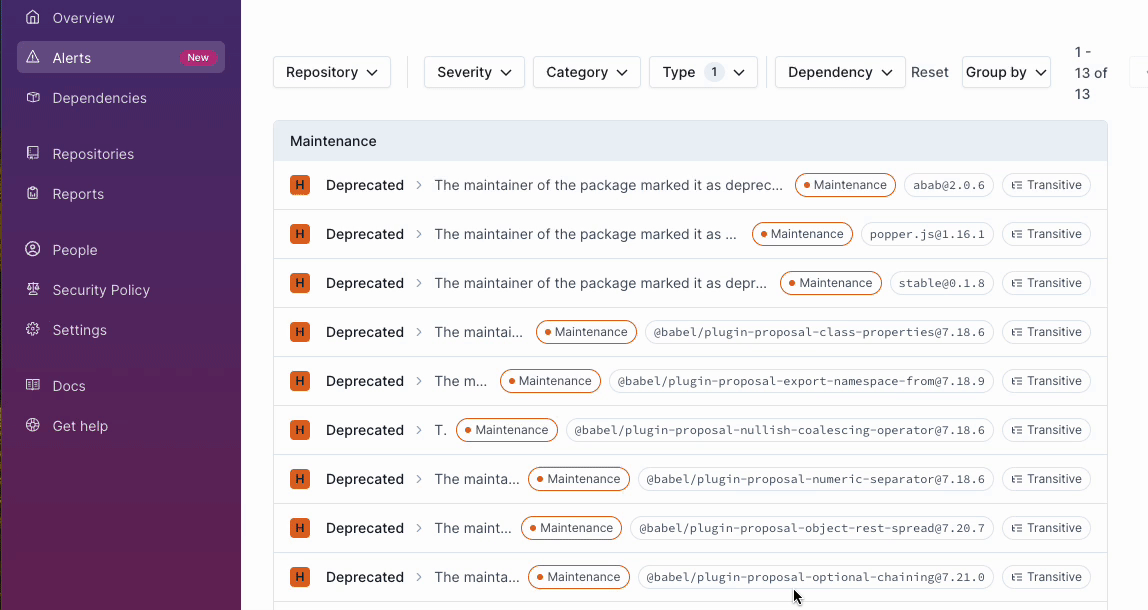Critical CVE
Severity
Critical
Short Description
Contains a Critical Common Vulnerability and Exposure (CVE).
Suggestion
Remove or replace dependencies that include known critical CVEs. Consumers can use dependency overrides or npm audit fix --force to remove vulnerable dependencies.
Information
A Critical CVE (Common Vulnerabilities and Exposures) alert signifies a severe security vulnerability within a package that can potentially lead to major security breaches. CVEs are standardized identifiers for known security vulnerabilities in software.
Socket’s AI-powered threat detection flags packages with critical CVEs to ensure immediate attention and action. These vulnerabilities are typically well-documented and can include issues like remote code execution, privilege escalation, or severe data breaches. Addressing them is crucial to maintaining the security and integrity of your system.
Why Critical CVEs are Important:
- Severity of Impact: Critical CVEs often lead to catastrophic damage such as unauthorized access, data leaks, or complete system compromise. Ignoring these vulnerabilities can result in significant harm to your system and organization.
- Public Disclosure: CVEs are publicly disclosed and documented in various security databases, making it easier for attackers to exploit these known vulnerabilities if left unpatched.
- Compliance and Trust: Addressing CVEs is often a compliance requirement for various industry standards and helps maintain the trust of users and stakeholders.
Recommended actions
A Critical CVE signifies a severe security vulnerability that can potentially lead to major security breaches, such as remote code execution, privilege escalation, or severe data breaches.
Suggested Action Configuration
Alert Action: Block
- Justification: Critical CVEs often lead to catastrophic damage such as unauthorized access, data leaks, or complete system compromise. Blocking these alerts ensures immediate attention and action to prevent significant harm.
- Action: Block the package immediately. This will fail the Socket CI/CD check, effectively blocking the PR or MR until the issue is resolved. This level is strict: if a Socket scan fails, so does your PR or MR. To prevent developers from bypassing these alerts, GitHub users, for example, can enable branch protection and set the PR to fail if the Socket scan fails.
Investigate the Dependency:
- Verify the CVE by checking the official CVE database and reviewing the vulnerability details.
- Assess the impact on your project, considering risks like data breaches, remote code execution, or unauthorized access.
Update or Replace the Dependency:
- Update: If a newer, patched version is available, update immediately.
- Replace: If no secure update exists, consider replacing the package with a safer alternative.
- Search for Alternatives: Identify other packages that offer similar functionality and are actively maintained. Scrolling down on the Socket package page, you will find AI-powered suggestions for alternative packages with similar capabilities:

Pin Dependency Versions:
- Lock the dependency to a specific, secure version to avoid future vulnerabilities.
Examples
- XZ Utils backdoor (CVE-2024-3094): An example is CVE-2024-3094, which involved a backdoor in the XZ Utils package. This backdoor was discovered in the upstream tarballs of XZ Utils, starting with version 5.6.0. The malicious code included obfuscated instructions for building with automake, which did not exist in the repository. These instructions extracted a prebuilt object file that modified specific functions in the code, potentially allowing malicious actors to gain access to affected systems through applications linked to the modified library, like sshd (Tenable®) (GitHub).
- Heartbleed (CVE-2014-0160): A critical vulnerability in the OpenSSL cryptographic software library that allowed attackers to read sensitive data from a server's memory.
- Shellshock (CVE-2014-6271): A critical flaw in the Bash shell that allowed attackers to execute arbitrary commands on an affected system.
Detection Method
Socket integrates with the GitHub Security Advisory Database to ingest Common Vulnerabilities and Exposures (CVEs) and other security advisories.
Critical CVEs:
- Criteria: CVEs with a CVSS score of 9.0 or higher.
- Action: Generate a high-priority alert. Recommend immediate action to mitigate the risk.
- Example: "Critical CVE detected in package X. Immediate action required to patch the vulnerability."
By integrating with the GitHub Security Advisory Database, Socket provides robust protection against vulnerabilities in open-source dependencies.
GitHub Security Advisory Database:
The GitHub Security Advisory Database is a comprehensive resource that contains security advisories from various sources, including the National Vulnerability Database (NVD), community submissions, and advisories curated by GitHub. It helps developers stay informed about vulnerabilities that could affect their projects.
For more information about the GitHub Security Advisory Database, visit GitHub Advisory Database.
Additional resources
National Vulnerability Database (NVD):
- The NVD is a comprehensive repository of known vulnerabilities maintained by the National Institute of Standards and Technology (NIST). It provides detailed information about each CVE, including severity ratings, descriptions, and references.
- NVD Website
MITRE CVE Database:
- MITRE manages the CVE list, which includes identifiers and descriptions of publicly disclosed cybersecurity vulnerabilities.
- MITRE CVE Database
GitHub Security Advisories:
- GitHub provides a platform for reporting and tracking vulnerabilities in open-source projects hosted on GitHub. This includes detailed advisories on CVEs affecting these projects.
- GitHub Security Advisories
CVE Details:
- This website provides detailed information about CVEs, including statistics, timelines, and affected products.
- CVE Details
Socket Blog: